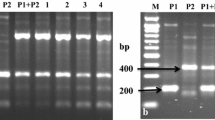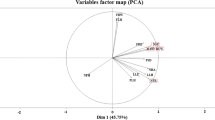Summary
More than 28,000 pollinations were carried out between 5 Ipomoea batatas and 41 diploid I. trifida accessions of diverse origins to obtain 4x interspecific hybrids. From the resultant 730 seeds, 248 plants were finally obtained. Ploidy level determination of the progeny showed unexpected results: 52 individuals were hexaploid, 5 were pentaploid, 190 were tetraploid, as expected, and one was not determined. The existence of 5x and 6x progenies from 6x x 2x crosses not only confirmed the presence of 2n gametes but also their successful function in gene flow between ploidy levels and polyploidization within this genus. The progeny and their cultivated parents were planted in an observation field. The cultivated parents produced 0.49 kg/plant or less. Most 4x progenies did not produce storage roots or had very poor yields; nonetheless, and despite their cultivated parents' poor yields, 8 genotypes yielded between 0.81 and 1.50 kg/plant.
A new scheme, using the 4x interspecific hybrids, is proposed for evaluating 2x and 4x wild accessions of the section Batatas to which the sweet potato belongs. Other possible uses of the 4x hybrids in breeding and genetics of the sweet potato are also discussed.
Similar content being viewed by others
References
Austin DF (1978) The Ipomoea batatas complex. I. Taxonomy. Bull Torrey Bot Club 105:114–129
Austin DF (1988) The taxonomy, evolution and genetic diversity of sweet potatoes and related wild species. In: Exploration, maintenance, and utilization of sweet potato genetic resources. Report of the First Sweet Potato Planning Conference, CIP, 1987. Lima, Peru, pp 27–59
Bingham ET (1980) Maximizing heterozygosity in autopolyploids. In: Lewis WH (ed) Proc Int Conf Polyploidy: Biological Relevance. Washington University, St. Louis, May 24–27, 1979. Plenum Press, New York, pp 471–489
Chase SS (1963) Analytic breeding in Solanum tuberosum L. — a scheme utilizing parthenotes and other diploid stocks. Can J Genet Cytol 5:359–363
Huaman Z, De la Puente F (1988) Development of a sweet potato gene bank at CIP: CIP Circ 16:1–7
Eckenwalder JE, Brown BP (1986) Polyploid speciation in hybrid morning glories of Ipomoea L. sect. Quamoclit Griseb. Can J Genet Cytol 28:17–20
Freyre R, Orjeda G, Iwanaga M (1991) Use of Ipomoea trifida (H. B. K.) G. Don germ plasm for sweet potato improvement. 2. Fertility of synthetic hexaploids and triploids with 2n gametes of I. trifida, and their interspecific crossability with sweet potato. Genome 34:209–214
Iwanaga M (1988) Use of wild germ plasm for sweet potato breeding. In: Exploration, maintenance and utilization of sweet potato genetic resources. Report of the First Sweet Potato Planning Conference, CIP, 1987. Lima, Peru, pp 199–210
Iwanaga M, Freyre R, Orjeda G (1991) Use of ipomoea trifida germplasm for sweet potato improvement. 1. Development of synthetic hexaploids of I. trifida by ploidy level manipulations. Genome 34:201–208
Jones A (1967a) Should Nishiyama's K123 (I. trifida) be designated I. batatas? Econ Bot 21:163–166
Jones A (1967b) Theoretical segregation ratios of qualitatively inherited characters for hexaploid sweet potato (Ipomoea batatas L.). US Dep Agric Tech Bull 1368
Kobayashi M (1978) Sweet potato breeding method using wild relatives in Japan. Trop Agric Res 11:1–8
Kobayashi M (1984) The Ipomoea trifida complex closely related to sweet potato. In: Proc 6th Symp Int Soc Trop Root Crops, CIP, 1983. Lima, Peru, pp 561–568
Kokubu T, Murata T, Endo F (1982) Anatomical observations on the fertilization and embryogenesis in sweet potato Ipomoea batatas (L.) Lam Jpn J Breed 32:239–246
Kumagai T, Umemura Y, Baba T, Iwanaga M (1990) The inheritance of β-amylase null in storage roots of sweet potato. Ipomoea batatas (L.) Lam Theor Appl Genet 79:369–376
Ling CP (1984) Genetic variability in interspecific F1 hybrids between Ipomoea batatas L. and I. littoralis B. M. Sc. thesis, Zhang Tsu Province, China (in Chinese with English abstr)
Martin FW (1959) Staining and observing pollen tubes in the style by means of fluorescence. Stain Technol 34:125–128
Martin FW, Jones A, Ruberte RM (1974) A wild Ipomoea species closely related to the sweet potato. Econ Bot 28:287–292
Nishiyama I (1959) Collecting the sweet potato and its allied species in U.S.A. and Mexico. Jpn J Breed 9:73–78
Nishiyama I (1963) The origin of the sweet potato plant. In: Barrau J (ed) Plants and the migration of the Pacific peoples. Bernice P. Bishop Museum, Honolulu, Hawaii, pp 119–128
Nishiyama I, Teramura T (1962) Mexican wild forms of sweet potato. Econ Bot 16:304–314
Orjeda G (1990) Desarrolloy y uso de híbridos interspecíficos entre Ipomoea batatas Lam. (2n=6x=90) e Ipomoea (H.B.K.) G. Don (2n=2x=30) como probadores de especies silvestres diploides y tetraploides. M. Sc. thesis, National Agrarian University (La Molina), Lima, Peru
Orjeda G, Iwanaga M, Freyre R (1990) Production of 2n pollen in diploid Ipomoea trifida, a putative wild ancestor of sweet potato. J Hered 81:462–467
Peloquin SJ, York GL, Werner JE, Darmo E (1989) Potato breeding with haploids and 2n gametes. Genome 31:100–1004
Sakamoto S (1976) Breeding of a new sweet potato variety, Minamiyutaka, by the use of wild relatives. JARQ 10:183–186
Author information
Authors and Affiliations
Additional information
Communicated by G. Wenzel
Rights and permissions
About this article
Cite this article
Orjeda, G., Freyre, R. & Iwanaga, M. Use of Ipomoea trifida germ plasm for sweet potato improvement. 3. Development of 4x interspecific hybrids between Ipomoea batatas (L.) Lam. (2n=6x=90) and I. trifida (H.B.K) G. Don. (2n=2x=30) as storage-root initiators for wild species. Theoret. Appl. Genetics 83, 159–163 (1991). https://doi.org/10.1007/BF00226245
Received:
Accepted:
Issue Date:
DOI: https://doi.org/10.1007/BF00226245




